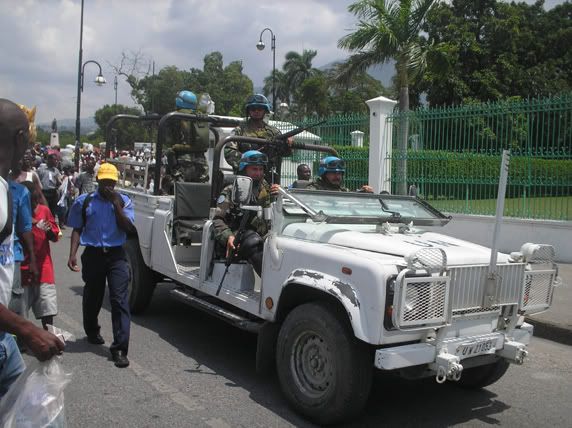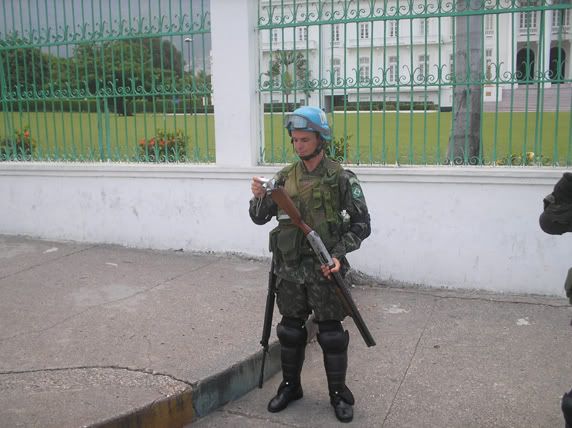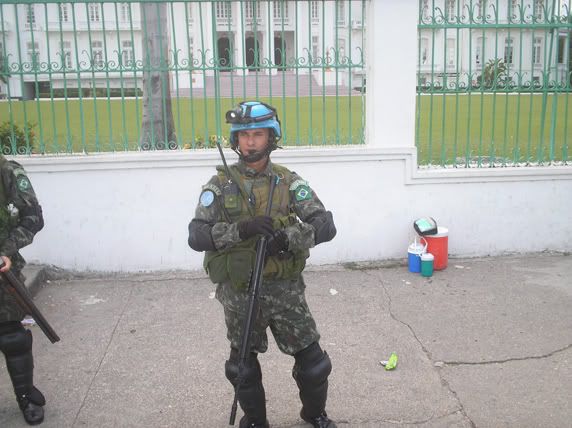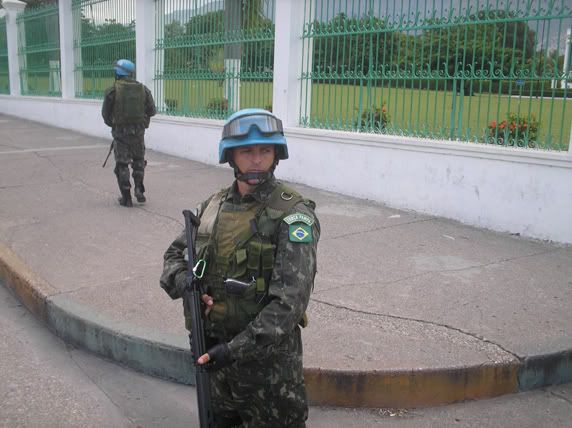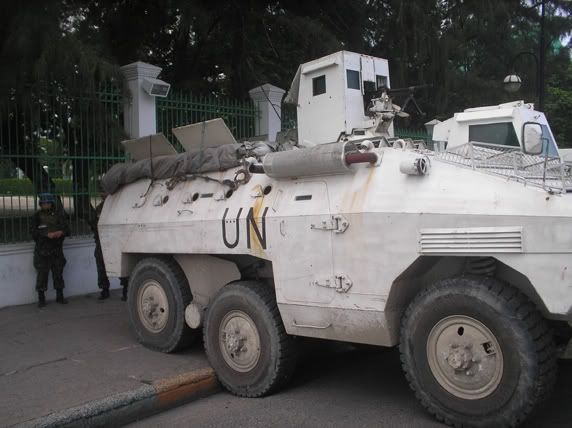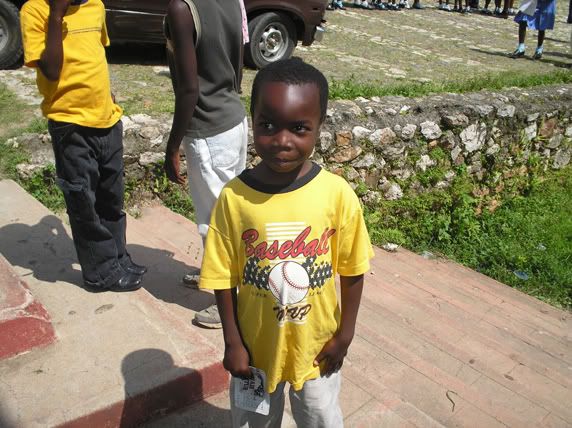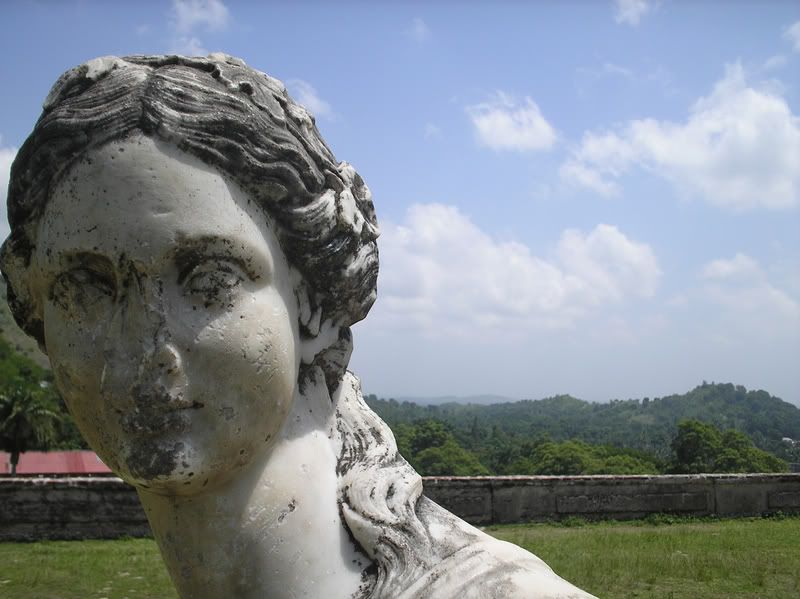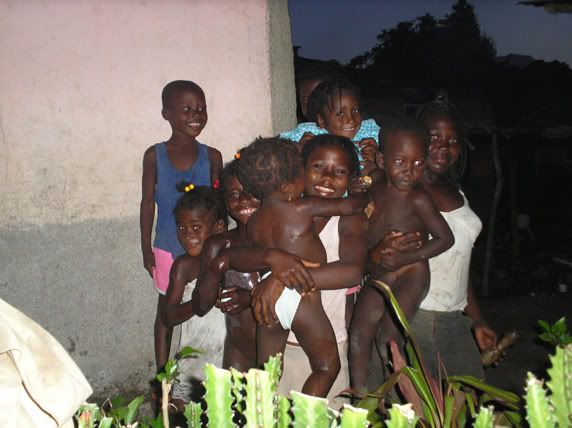By Jeb Sprague and Wadner Pierre
A normally bustling street in Port-au-Prince on Jun. 13, 2007 during the two-day transport strike.
Credit:Wadner Pierre
PORT-AU-PRINCE, Jun 19, 2007 (
IPS) - A two-day transport strike last week gripped Haiti's major cities and underscored a mounting crisis over fuel prices, which rose nearly 20 percent in just two weeks.
On Jun. 12 and 13, transport workers shut off their engines, leaving residents of Port-au-Prince and other urban centres largely without the services of taxis or the colourful buses and pick-up trucks known as tap-taps.
A spokesperson for the Initiative de Secteur de Transport, an ad hoc strike committee representing 18 transport unions, Benissoit Duclos, said the action was driven by three pressing issues.
First, the government "has increased traffic fines so that what was a 50-gourde fine is now 1,000 gourdes and what was a 500 gourd fine is now 10,000 gourdes," he said.
"Second, over the last three to four years, the government has not charged for nor distributed registration stickers for vehicles. They are now distributing these but ordering a lump sum payment of 4,000 gourdes for all the years that these were not distributed," Duclos told IPS.
Lastly, the price of gasoline has become unaffordable for most drivers, rising by 34 gourdes to 207 gourdes per gallon this month. Many workers, with a salary that hovers around 70 gourdes a day, must spend 20 to 40 gourdes on transportation (35.4 gourdes equal one U.S. dollar).
The striking workers drive cars and buses, which the working poor depend on for transportation. While some drivers use company cars, many cars are independently owned.
"Poor people, the majority working in the informal economy or assembly industry, cannot afford the higher costs of transportation that these measures would force upon us," said Changeux Méhu, president of ATCH, a union of bus drivers.
"The people don't feel they have a say in government policy," he told IPS.
The strikers appear to enjoy broad national support with a coalition including the Fédération des Transporteurs du Nord, the Fédération des Transporteurs de l'Artibonite and the south based Association des Propriétaires de Conducteurs du Haïti.
On the first day of the strike, Rétes Réjouis, a coordinator of the Fédération des Transporteurs Publics Haïtiens, a well organised transport co-op, declared support for the strike.
"It is a nationwide strike from the grassroots," one transport worker told IPS. A roster of the unions does not include the numerous small but heavily foreign donor-backed labour groups often held up in the international media as "independent".
Haiti's Minister for Social Affairs and Work, Gerald German, voiced surprise that the workers would launch a strike. But Duclos argues that the Rene Preval government has become too close with big business and "the people that supported the de facto government and 2004 coup" - referring to the overthrow of the elected Jean-Bertrand Aristide government and the creation of an interim government.
Interim appointees backed by the United States, including President Boniface Alexander and Prime Minister Gerard Latortue, discharged Haiti's large businesses from paying many of their taxes. Trade unionists interviewed noted with irony that poor vehicle owners are now being forced to pay back registration fees.
Interim authorities also launched the Cadre de Coopération Intérimaire (CCI), a macro-economic adjustment programme largely formulated by international donor institutions and the local groups they back.
Thousands of public sector workers were laid off and government ministries were placed under foreign financial supervision. Mark Schueller at the University of California, Santa Barbara who has studied the CCI, says that it also "promoted high-value crops for exports, benefiting few Haitian farmers" while strengthening the "importation of subsidised or monetised rice, draining Haitian peasants' productive capacity to feed Haiti."
In 2006, after a heated election, René Garcia Préval won the presidency with wide popular support. More than a year later, appointees from the interim government remain in numerous high-level posts and a large U.N. force is deployed in the country.
With the fanfare surrounding Preval's inauguration and good relations with Venezuela, many believed that Haiti's entry into PetroCaribe, a Venezuelan-backed programme offering oil at preferential rates to Caribbean countries, would alleviate high gasoline costs.
Rather than selling oil directly to the companies active in Haiti, such as Esso/Exxon Mobil, Chevron-Texaco, Total and Dynasa, Venezuela's state oil corporation, PdVSA, will sell it to the Preval government, which will in turn sell to the companies at the same price.
The government profits by purchasing a large part on credit with low interest rates and a long grace period. Preval has indicated that the government will then bank the money, gathering interest.
This is especially helpful as Haiti's government has long been susceptible to foreign pressure through its financial dependency on donors. Haiti's meagre tax revenues have left it unable to fund its own national investment budget.
A symbolic shipment of oil from Venezuela arrived on Preval's inauguration in May 2006, but in recent months, PetroCaribe has stalled. Terms were signed on Mar. 12, 2007 during Venezuelan President Hugo Chavez's visit to Haiti, and shipments were supposed to begin in July. But the two large U.S. oil companies that export to Haiti are said to have stonewalled negotiations.
Leaders of the transport unions told IPS that they hoped PetroCaribe would directly benefit the poor, lowering prices at the pump. But under the Preval government's plan, this will not happen. PetroCaribe has nothing to do with the cost of fuel, Preval says, insisting he will not subsidise the cost of fuel, which is determined by market prices.
Hyppolite Pierre, a Haitian author and a professor at the Community College of Baltimore County in Maryland, observes that "international lenders such as the IMF, the World Bank and the IDB [Inter-American Development Bank] consider such subsidies as a waste and therefore strongly discourage those practices."
The influential U.S. embassy in Port-au-Prince has long pushed for a non-subsidised floating fuel price.
In 2002, a document purported to have originated from the U.S. government or international financial institutions threatened that major petroleum companies would cut off their exports to Haiti if the government did not end its subsidisation of oil. Haiti, with no alternative source of petroleum, was pressured to comply.
But Haiti's Prime Minister Jacques Edouard Alexis insists that even with PetroCaribe in place, "The government cannot subsidise the price of oil, because Haiti does not produce oil."
Transport workers, now in talks with the government, say it is essential the government subsidise fuel or they will simply be unable to operate. For many workers in the informal economy and garment sector, half their wages are spent on transportation.
Dozens of community schools and a slew of literacy centres, once subsidised by the Aristide government, are now cut off from government funds and suffering from rising fuel prices, since they often rely on generators for electricity.
In the Petion-ville district of Port-au-Prince, one community school, SOPUDEP, has come under pressure. The mayor of Petion-ville has attempted to get the school closed down, say school employees.
Rea Dol, head of SOPUDEP, said, "The situation requires prompt intervention by the state. After all people went through to vote for President Preval, he must respond to the population."
Because of this, "we support the strike," she said, "so that it puts pressure on the government to see that people are suffering."
*Jeb Sprague and Wadner Pierre contribute to Haitianalysis.com. (END)



